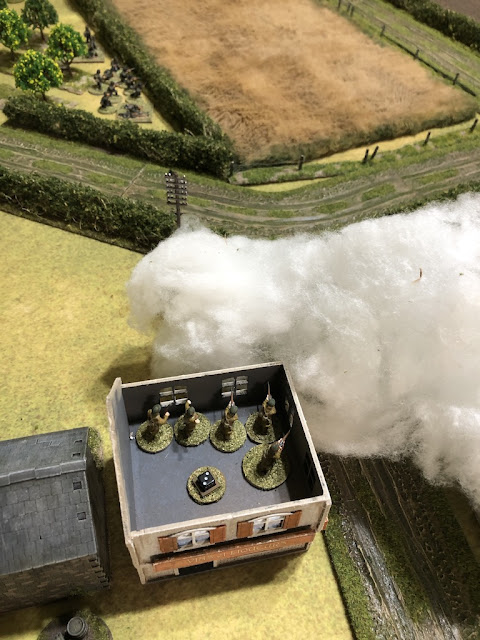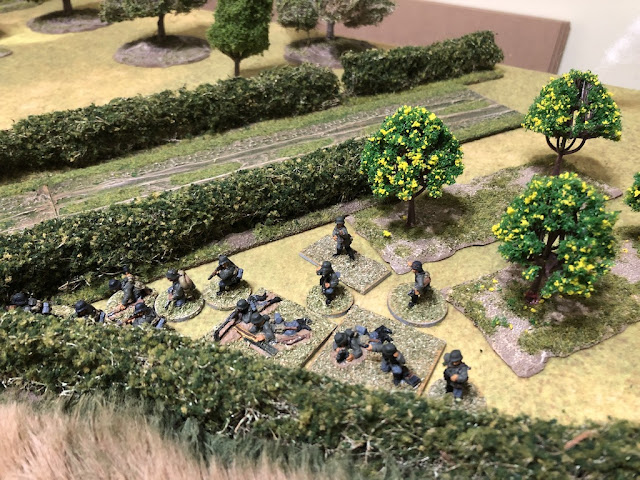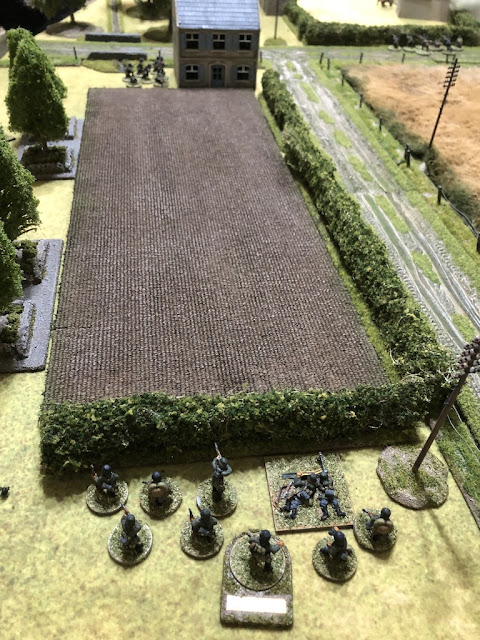The next scenario calls for the French to demolish two important culverts in the vicinity of Noirmont. The Germans must stop them in order to maintain the pace of their offensive (this is supposed to be blitzkrieg after all). French engineers must first set their charges and then use a full CoC die to detonate them. Time is not on their side, they must act quickly while the platoon and whatever support it can muster keep the Germans at bay. If the French succeed this delays the Germans for an additional campaign turn which would be enough to see them run out of time and face defeat. Consequently my Germans must win this table at the first attempt. Like I said earlier, there is no margin for error.
Here is the table from the French perspective with a small culvert on their right flank and a large one at the rear.
The charges for the small culvert require six task points to set. Each time the engineers are activated they roll 1D6 to determine how many task points they have accumulated during the phase, which makes it quite possible that could occur in only one or two phases.
The Germans must find a way to disrupt French deployment while moving as quickly as possible themselves. The key to the game is the small culvert. If it can be captured before the French destroy it then I believe there is a good chance of winning.
The French have a full strength fresh platoon, but that same platoon must fight all the actions on this and the next two tables so they cannot afford to take too many losses.
The Germans can call on armoured support for this scenario and with eleven support points available it's certainly an option I've considered (note that it should be twelve support points for this scenario but the low opinion of the German CO has reduced the amount available). I suspect Dave will be expecting something like this and will have adequate anti-tank support. Nonetheless I do give serious thought to a PzIV because its 75mm HE rounds could be very useful if the French defenders prove stubborn, yet in the end I decide against it.
I will call on a motorcycle reconnaissance squad to not only provide extra men but the ability for rapid movement should an opportunity arise. In order to maximise leadership on the table the platoon will have the support of an adjutant. A Stuka bombardment will attempt to disrupt the French defence and hamper their deployment and finally, a shabby Nazi trick in the form of a 5th columnist should further disrupt French coordination.
The game starts with German force morale at eight and the French at nine, giving them the initiative and the opening phase. During the patrol phase I try to make some headway on my left flank towards the small culvert, but the French respond quickly and so two of my jump-off-points are in fairly exposed positions. I place my third over on my right flank which will provide a covered approach towards the large culvert.
Before we begin the Stukas arrive to soften up the defence. Unfortunately the first bombs miss the building closest to the small culvert. I was really hoping to cause it damage and so limit its use to the French, but no matter, there are more Stukas to follow.
The final Stuka hits the building on the German right flank making it unstable and hazardous to occupy.
That Stuka bombardment was more successful than the one during the first playing of the scenario at Perbais, so there can be no complaints. Damage has been inflicted and this should make it a little more difficult for the French to build a cohesive defence. I'm now hoping the bombardment is just as successful in disrupting their deployment.
Things don't get off to a great start when the first French command roll delivers a double phase. Time is against them and this is just the sort of start they need. The only consolation is that the command roll does not allow an engineer team to activate.
A Groupe tries to deploy but fails to make it through the Stuka barrage. An attempt by a second Groupe does succeed and they deploy into the house by the small culvert, just the one I was hoping the Stuka attack would deny them. Had I been a bit more alert I should have used my 5th columnist. My attention was distracted by the amount of shock the Stuka bombardment may place on the deploying Frenchmen.
A Groupe tries to deploy but fails to make it through the Stuka barrage. An attempt by a second Groupe does succeed and they deploy into the house by the small culvert, just the one I was hoping the Stuka attack would deny them. Had I been a bit more alert I should have used my 5th columnist. My attention was distracted by the amount of shock the Stuka bombardment may place on the deploying Frenchmen.
In the end it proves to be quite a lot with four points of shock on each French team. The Groupe Sergeant uses his command initiatives to immediately rally a point off each of those units.
The next French command roll is 54443, not the most useful and it means we won't see the appearance of any engineers this phase either. The platoon sergeant deploys through the Stuka bombardment and joins the Groupe in the upper level taking the opportunity to rally more shock off them as he does so.
In the following phase the first German squad deploys on their right flank and takes up tactical positions along the hedgerow.
The 50mm mortar team deploys and does fire, but it has no effect. This elicits a response from the French rifle team in the upper level who are on overwatch and they inflict a points of shock on the mortar team.
The next French command roll is 63211 and that means there is an opportunity for the engineer demolition team to begin work setting their charges on one of the culverts. First though, the platoon sergeant takes more shock off the rifle team and then has them move out of sight towards the back of the building.
It's no surprise to discover that the French engineers will try to work their way through the Stuka bombardment and deploy, which they do successfully. Dave is being cautious and so they don't go straight to the culvert but remain out of sight behind the building. It turns out to be a wise decision as they have taken five points of shock from the Stuka attack which sees them pinned.
In the German phase the Feldwebel orders the squad and mortar team to move forward along the hedge row. This they do at a good pace, moving 9" and 8" respectively.
Another squad deploys in the centre. They are in open ground and so take up tactical positions as they can be targeted from the upper level of the house.
In the French phase the platoon sergeant rallies the last point of shock off the rifle team before moving downstairs to where he can rally shock off the engineers. Meanwhile on the lower level the Groupe sergeant takes two points of shock off the LMG team. Despite arriving with a fair amount of shock the presence of two leaders and the early double phase has enabled the Groupe to gather its senses ready for the fight ahead.
In the German phase the Feldwebel continues to urge the squad and mortar team forward. Once again they move at a good pace and that brings the LMG team within sight of the French engineers.
Having said that I want to keep pressure on the French. I was holding back the motorcycle squad in case of a double phase or an unexpected opportunity to try a coup de main that would see them come roaring up the road on their motorcycles. Instead I decide on something a little more pedestrian (literally and figuratively). Taking advantage of their ability to deploy 9" from a JoP I bring them on as far forward as possible on my left flank. They will be exposed in open ground and so they too take up tactical positions, but they won't need to move far to come outside of the arc of fire from the windows in the house.
The French platoon sergeant uses the next phase to rally two points of shock off the engineers.
Another French Groupe tries to make its way through the Stuka bombardment and this time they are successful. They plan to deploy from the JoP on the French left near the large culvert but I announce the presence of a 5th columnist. Unfortunately luck is not running my way and a roll of six sees the Groupe recognise him for who he is and they despatch him. With that the Groupe deploys into one of the houses hidden by the pall of smoke from the burning farmhouse.
In the German phase the Feldwebel takes the chance to hit the engineers behind the house and orders the LMG team to open fire.
The Feldwebel then orders the rifle team and mortar crew to come forward and join the LMG team from where they will all have a line of sight to the engineers.
In the centre the squad advance tactically up to the hedgerow ready to create a base of fire prior to any assault on the house.
On my left the motorcycle squad advance tactically across the open ground and just out of the arc of fire of the French at the windows of the house.
I don't feel the German assault is moving fast enough but I'm conscious of casualties and so prefer to take this slowly. The downside is it is allowing the French to recover the shock inflicted by the Stukas and sure enough in the following phase the sergeant of the recently deployed Groupe spends the phase further reducing the levels of shock.
Once again there is only one casualty and yet again it's a leader, the squad's obergefreiter who suffers a light wound. My leaders seem particularly vulnerable today.
The following German command roll of 61111 is not ideal but it does allow me to do the two most important things. On the left the rifle team move at the double and run up to the building which takes them within 4" of the French jump-off-point.
The last act of the phase is to have the squad opposite the house open fire, but they only manage to inflict a single point of shock.
At this point Dave decides he has little chance to destroy both culverts and stands only to suffer casualties which he can ill afford. With that the French platoon withdraws leaving both culverts undamaged and in German possession for a scenario victory.
That was a good outcome from my perspective, not only a scenario victory which was essential, but one achieved at no cost in casualties to the core platoon.
The only German casualty was the obergefreiter from the motorcycle squad which was a support unit. Similarly the French lost a single man from the engineer demolition team. A victory without heavy casualties is just the turnaround my platoon needs although we still move to the next scenario with the Men's Opinion at -9 and the CO's Opinion at -4. The platoon leader's outlook moves from the rather disgraceful 'In Shame' to a slightly improved 'Insecure'. The light casualties see the opinion of the French men rise to +8, however the scenario defeat sees the CO's Opinion drop to +4. The platoon leader's outlook moves from 'Happy' to 'Short Tempered'.
The campaign now moves on to Scenario 3 'Blitz on Villeroux' and you can follow the events of that game in this post.
The campaign now moves on to Scenario 3 'Blitz on Villeroux' and you can follow the events of that game in this post.



































































